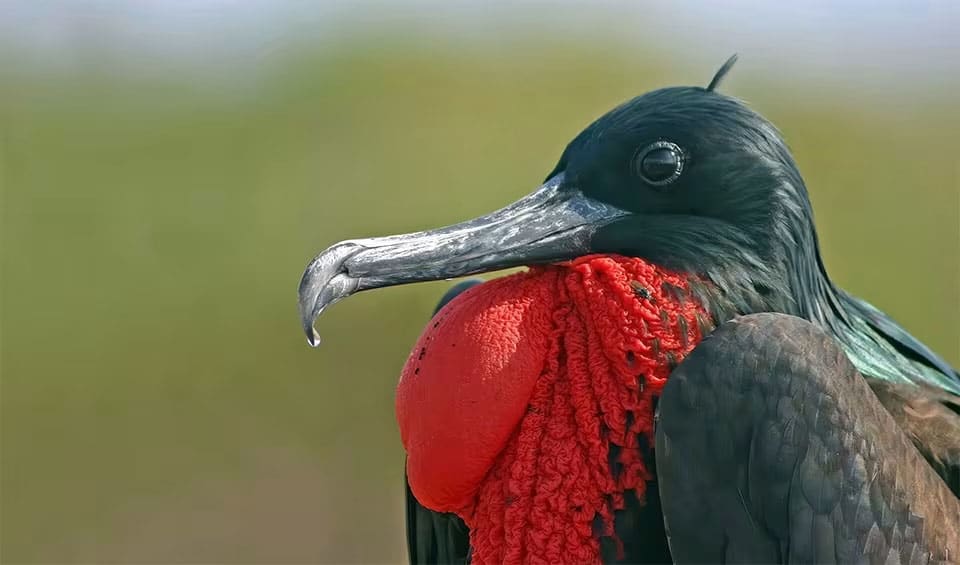One of the most adept aviators of the avian world, embodying the very essence of grace and efficiency in flight. These birds are a marvel of evolutionary adaptation, possessing the lowest wing loading (a measurement that considers the bird’s body mass relative to its wing area) of any bird. This allows them to remain airborne for weeks, only landing on remote tropical islands to breed and roost.
Great frigatebirds have a distinctive appearance, with long, slender wings spanning up to 2.3 meters (7.5 feet) and deeply forked tails that enable sharp, precise maneuvers. Their striking silhouette is easily recognizable against the open sky. These birds are built not for swimming but for soaring. Their feathers are not waterproof, and they avoid the sea surface to prevent their wings from getting wet, which could hinder their flight.
Instead of diving for food, great frigatebirds have mastered the art of kleptoparasitism – they harass other seabirds, such as boobies and tropicbirds, in mid-air until they regurgitate their catch, which the frigatebirds then snatch up. Their diet mainly consists of fish and squid, which they capture from the ocean’s surface or through theft.
The behavior of following pods of tuna and dolphins is strategic, as these marine predators drive schools of fish to the surface, making it easier for frigatebirds to access their food. This inter-species dynamic is a fascinating example of how different animals can inadvertently assist each other in the wild.
Breeding colonies of great frigatebirds are spectacular and typically found on isolated islands. The males display their gular pouch – a striking red, balloon-like sac on their throats – which they inflate like a balloon to attract females. These displays, accompanied by clattering bills and waving heads, are a dramatic and noisy spectacle.
Distribution
 American Samoa
American Samoa Aruba
Aruba Australia
Australia Brazil
Brazil British Indian T.
British Indian T. Brunei
Brunei Cambodia
Cambodia Chile
Chile China
China Christmas Island
Christmas Island Cocos Is. (Keeling)
Cocos Is. (Keeling) Colombia
Colombia Comoros
Comoros Cook Islands
Cook Islands Costa Rica
Costa Rica East Timor
East Timor Ecuador
Ecuador El Salvador
El Salvador Fiji
Fiji French Polynesia
French Polynesia French Southern T.
French Southern T. Guam
Guam Guatemala
Guatemala India
India Indonesia
Indonesia Japan
Japan Kenya
Kenya Kiribati
Kiribati Madagascar
Madagascar Malaysia
Malaysia Maldives
Maldives Marshall Islands
Marshall Islands Mauritius
Mauritius Mayotte
Mayotte Mexico
Mexico Micronesia
Micronesia Mozambique
Mozambique Nauru
Nauru New Caledonia
New Caledonia New Zealand
New Zealand Nicaragua
Nicaragua Niue
Niue Nort. Mariana Is.
Nort. Mariana Is. Oman
Oman Palau
Palau Panama
Panama Papua New Guinea
Papua New Guinea Philippines
Philippines Pitcairn
Pitcairn Réunion
Réunion Saint Helena
Saint Helena Samoa
Samoa Seychelles
Seychelles Solomon Islands
Solomon Islands Somalia
Somalia South Africa
South Africa Sri Lanka
Sri Lanka Taiwan
Taiwan Tanzania
Tanzania Thailand
Thailand Tokelau
Tokelau Tonga
Tonga Tuvalu
Tuvalu US Minor Is.
US Minor Is. United States
United States Official estimate
Official estimate
 Vanuatu
Vanuatu Vietnam
Vietnam Wallis & Futuna
Wallis & Futuna Zimbabwe
ZimbabweAnything we've missed?
Help us improve this page by suggesting edits. Glory never dies!
Suggest an editGet to know me
Terrestrial / Aquatic
Altricial / Precocial
Polygamous / Monogamous
Dimorphic (size) / Monomorphic
Active: Diurnal / Nocturnal
Social behavior: Solitary / Pack / Herd / Colony
Diet: Carnivore / Herbivore / Omnivore / Piscivorous / Insectivore
Migratory: Yes / No
Domesticated: Yes / No
Dangerous: Yes / No




